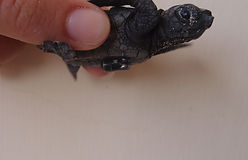Dr Rebecca Scott
Scientist

Adult sea turtles perform regular to-and-fro migrations between breeding and foraging grounds which are typically several 100’s to 1000’s of km apart. Whilst satellite tracking technology has been instrumental in documenting the migrations of adult sea turtles, newly hatched turtles (hatchlings) can also embark on transoceanic journeys (>10,000 km) by dispersing with ocean current flows. However, due to the small size of hatchlings they cannot be tracked at sea with large satellite tracking devices hence their first few years of life are commonly referred to as the "lost years". Nevertheless, since surface ocean currents are a primary determinant of their dispersion from predator rich coastal areas (near natal beaches) to safer oceanic development habitats, ocean models and surface oceanic drifters can be used to study the cryptic juvenile life stages.
The central themes of my research are based on:
(1) analysing of satellite tracking data to study the regular breeding migrations, behaviours and habitat selections of adult sea turtles
(2) simulating the cryptic dispersion patterns and habitats of hatchling sea turtles using ocean models and drifters
3) using recent innovations in the miniaturisation of acoustic bio-logging technology to track hatchling turtles as they start to disperse offshore.
4) developing novel turtle inspired oceanic monitoring/robotics technology to gain unique new insights into the cryptic swimming behaviours of hatchlings.
By conducting such novel, interdisciplinary research my work has provided key new insights into sea turtle life histories which have broad applications for conservation planning.


